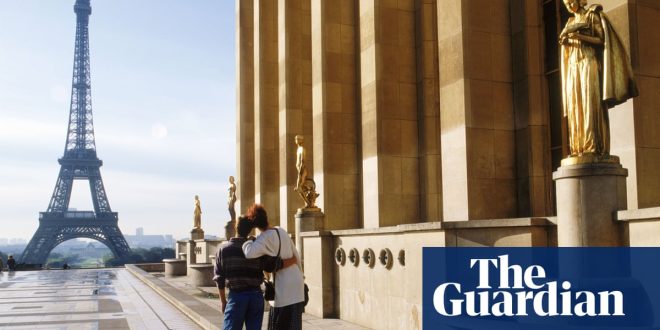City of Architecture and Heritage
This museum offers a tour of France’s most sensational buildings, from the middle ages to the present. It sits across the Seine from the Eiffel Tower in the eastern wing of the Chaillot Palace, which was built for the International Exhibition of 1937 and features full-scale casts of architectural features, copies of murals and frescoes and models of buildings.
Architect Eugène Viollet-le-Duc (1814–1879) conceived the idea of a museum of comparative sculpture, focusing on French monuments, as a way of promoting knowledge and awareness of medieval architecture. His plaster casts were made all over France and then assembled here.
The second floor is dedicated to the evolution of architecture in the 19th and 20th centuries. One model of Paris shows changes made to the city by Baron Haussmann from 1854; another shows an apartment from Le Corbusier’s post-second world war Cité Radieuse in Marseille. The museum also has reproductions of frescoes and French stained-glass windows from the Romanesque period to the dawn of the Renaissance.
This collection offers priceless insights to archaeologists and has guided renovation projects of churches, cathedrals and abbeys including Notre Dame cathedral. The museum has models of the cathedral’s frame and the spire that collapsed in the great fire of 2019.
Open Wed–Mon 11am – 7pm, Thurs open till 9pm,closed 24-27 July, €9, €6 concessions, citedelarchitecture.fr.en
Museum of the Liberation of Paris
On 25 August 2019, Paris celebrated the 75th anniversary of its liberation from Nazi control with a new museum dedicated to the victory and two of its leaders, General Jacques-Philippe Leclerc and resistance hero Jean Moulin. The museum’s location, treatment of the German occupation and the French resistance – and free admission – make it one of the most compelling museums in the city.
It is housed in one of two 18th-century toll houses directly above the former bunker command station of Henri Rol-Tanguy, a leader of the Parisian resistance. Below ground, a mixed reality headset introduces Tanguy, known as “Colonel Roy”, Moulin and other resistance fighters and shows how to make a street barricade.
Back up 100 steep steps at ground level, the museum covers the occupation from its beginning on 25 June 1940, with displays about those who fought a clandestine war against the occupation, as well as Leclerc and the Free French 2nd Armoured Division. Nazi propaganda posters, stories of resistance battles and moving video interviews fill the route to a room dedicated to the events of the six days of liberation that began on 19 August 1945. Each day is recounted in detail, starting with the leaflet calling on all Parisians to fight, and continuing through stories of street battles, the Nazi surrender to Leclerc’s troops and General de Gaulle’s arrival in Paris.
During the Occupation, Parisian Marguerite Sabaut made a dress decorated with several Parisian monuments, hoping to wear it one day with its matching earrings and a handbag decorated with the Cross of Lorraine, the symbol of Free France. Madame Sabaut wore her ensemble to the parade on the Champs-Elysées on 26 August. These are some of the many poignant mementoes of the Liberation on display here.
Open Tue–Sun 10am–6pm, free, museeliberation-leclerc-moulin.paris.fr/en
Petit Palais
The Petit Palais was built to introduce the world to French art at the 1900 Universal Exhibition. It is now the city’s museum of fine arts, featuring works from antiquity to the modern era, with an eclectic range of paintings, sculpture and furniture. It is best known, however, as a museum of late 19th- and early 20th-century art.
Galleries show the rise of realism in painting, starting with Gustave Courbet. Among his notable works is Le Sommeil (The Sleepers), a daring canvas portraying two intertwined naked women. The painting was commissioned by a Turkish diplomat intrigued by Courbet’s portrayal of women, and it provoked considerable scandal.
Realist painters strove to depict urban life and working-class communities, and the city of Paris supported this movement through its purchases. In 1889, Léon Lhermitte was commissioned to paint a monumental work for the Paris City Hall: Les Halles, depicting the city’s historic food market, caused a sensation at the 1895 Paris Salon. While some criticised its subject matter as trivial, others praised the vitality of the scene and the painter’s virtuosity. In 1904, the artwork found its home in the Petit Palais but was later rolled up and stored for more than 80 years before being restored and returned to display.
Fernand Pelez devoted himself to painting the lives of the humble and destitute. His sombre La Parade des Humbles is a critical depiction of circus performers, portraying the circus as a joyless affair of fatigue and tired tricks. These canvases represent the Paris of Émile Zola, and for a long time they were overlooked and forgotten. Recognising their significance, the Petit Palais has rightfully brought these brilliant works back into the public eye.
Open Tue–Sun 10am–6pm, free, petitpalais.paris.fr/en.
Méliès Museum at La Cinémathèque Française
La Cinémathèque Française, with its library, comprehensive retrospective film series and rich exhibitions, is at the centre of film-making culture in France. It is fitting that its museum is dedicated to the life and work of Georges Méliès, a pioneer of cinema and a hero to generations of film-makers, set designers and special effects artists.
In the Martin Scorsese film Hugo, Méliès is played by Ben Kingsley, and much of the biographical detail in that semi-fictional film is accurate. Méliès was a magician who plied his trade at the theatre he bought from the widow of illusionist Jean-Eugène Robert-Houdin (from whom Harry Houdini took his name). Over two decades, after his exposure to the films of the Lumière Brothers in 1895, Méliès wrote, directed and starred in hundreds of short films made by his Star Film company, incorporating his illusions in his moving pictures.
One of his first shorts showed him making a woman disappear, in an early example of trick editing. He was also known for combining multiple exposures into a single shot, a technique known as superimposition. After international success, interest in Méliès’s films largely disappeared about the same time as he went into debt and he was forced to close his company. In 1923, he sold the theatre and his glass-enclosed studio in Montreuil, and destroyed or sold his negatives.
The museum displays early film equipment, including the cinématographe and kinétoscope, as well as objects associated with Méliès, such as magic equipment, his personal 35mm film camera, costumes, posters and models. It also screens the entire 1902 film A Trip to the Moon, Méliès’s masterpiece – which is a special effects marvel and, at just under 14 minutes, a long movie for its time.
Open Mon, Wed–Fri 12pm-7pm, Sat & Sun 11am–8pm, €10, 18-25 €7,50, under 18 €5, cinematheque.fr/musee-melies-la-magie-du-cinema.html
Galliera Palace Museum
For fashion enthusiasts, the Palais Galliera serves as a sanctuary. Built in the late 19th century, the beaux-arts-style building is the work of architect Paul-René-Léon Ginain, designed according to the specifications of Maria Brignole Sale de Ferrari, Duchess of Galliera, who wanted a place to display her art collection.
Completed in 1894, it was later donated to the city, and in 1977 was opened as a museum dedicated to fashion. It has been recently renovated, with new galleries offering a tour of fashion from the 18th century to the present day, with regularly renewed displays.
This sumptuous collection of more than 200,000 pieces includes clothing, accessories, posters, drawings and photographs. In a chronological and thematic journey, visitors discover the evolution of fashion through extraordinary pieces that demonstrate their makers’ creativity and expertise. Garments on display range from 18th-century menswear to avant garde designs, 19th-century corsets to 1950s cocktail dresses, with work by Yves Saint Laurent, Cristóbal Balenciaga, Christian Dior and other icons of design.
Christian Dior’s first collection in 1947 marked a turning point in fashion history. His New Look silhouette, with rounded shoulders, a defined waist and full skirts reintroduced an idealised femininity, breaking free from the constraints of the wartime period. This event signalled the beginning of a new golden age for haute couture and reinstated Paris as the fashion capital of the world.
Open Tue–Sun 10am – 6pm, Thurs open till 9pm, 12€, 18-26 and students €10, under 18s free, palaisgalliera.paris.fr/
This is an edited extract from 111 Museums in Paris That You Shouldn’t Miss by Anne Carminati and James Wesolowski, published by 111 PLACES (£13.99).
 Top Naija News – Nigeria News, Nigerian News & Top Stories Top Naija News – Nigerian Newspapers, Nigerian News. topnaijanews is a daily Nigerian newspaper covering Latest News, Breaking News, Entertainment, Sports, Lifestyle and Politics.
Top Naija News – Nigeria News, Nigerian News & Top Stories Top Naija News – Nigerian Newspapers, Nigerian News. topnaijanews is a daily Nigerian newspaper covering Latest News, Breaking News, Entertainment, Sports, Lifestyle and Politics.




